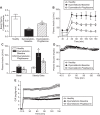Pioglitazone increases whole body insulin sensitivity in obese, insulin-resistant rhesus monkeys
- PMID: 25954816
- PMCID: PMC4425551
- DOI: 10.1371/journal.pone.0126642
Pioglitazone increases whole body insulin sensitivity in obese, insulin-resistant rhesus monkeys
Abstract
Hyperinsulinemic-euglycemic clamps are considered the "gold standard" for assessing whole body insulin sensitivity. When used in combination with tracer dilution techniques and physiological insulin concentrations, insulin sensitization can be dissected and attributed to hepatic and peripheral (primarily muscle) effects. Non-human primates (NHPs), such as rhesus monkeys, are the closest pre-clinical species to humans, and thus serve as an ideal model for testing of compound efficacy to support translation to human efficacy. We determined insulin infusion rates that resulted in high physiological insulin concentrations that elicited maximal pharmacodynamic responses during hyperinsulinemic-euglycemic clamps. These rates were then used with [U-13C]-D-glucose, to assess and document the degrees of hepatic and peripheral insulin resistance between healthy and insulin-resistant, dysmetabolic NHPs. Next, dysmetabolic NHPs were treated for 28 days with pioglitazone (3 mg/kg) and again had their insulin sensitivity assessed, illustrating a significant improvement in hepatic and peripheral insulin sensitivity. This coincided with a significant increase in insulin clearance, and normalization of circulating adiponectin. In conclusion, we have determined a physiological clamp paradigm (similar to humans) for assessing glucose turnover in NHPs. We have also demonstrated that insulin-resistant, dysmetabolic NHPs respond to the established insulin sensitizer, pioglitazone, thus confirming their use as an ideal pre-clinical translational model to assess insulin sensitizing compounds.
Conflict of interest statement
Figures



Similar articles
-
Phenotyping of adipose, liver, and skeletal muscle insulin resistance and response to pioglitazone in spontaneously obese rhesus monkeys.Am J Physiol Endocrinol Metab. 2017 Apr 1;312(4):E235-E243. doi: 10.1152/ajpendo.00398.2016. Epub 2017 Jan 31. Am J Physiol Endocrinol Metab. 2017. PMID: 28143858
-
Inflammatory cytokines and chemokines, skeletal muscle and polycystic ovary syndrome: effects of pioglitazone and metformin treatment.Metabolism. 2013 Nov;62(11):1587-96. doi: 10.1016/j.metabol.2013.07.004. Epub 2013 Aug 17. Metabolism. 2013. PMID: 23958241 Clinical Trial.
-
Chronic treatment with pioglitazone does not protect obese patients with diabetes mellitus type II from free fatty acid-induced insulin resistance.J Clin Endocrinol Metab. 2007 Jan;92(1):166-71. doi: 10.1210/jc.2006-1518. Epub 2006 Oct 24. J Clin Endocrinol Metab. 2007. PMID: 17062758
-
Direct comparison among oral hypoglycemic agents and their association with insulin resistance evaluated by euglycemic hyperinsulinemic clamp: the 60's study.Metabolism. 2009 Aug;58(8):1059-66. doi: 10.1016/j.metabol.2009.03.007. Epub 2009 Jun 18. Metabolism. 2009. PMID: 19394976 Clinical Trial.
-
Pioglitazone treatment enhances the sympathetic nervous system response to oral carbohydrate load in obese individuals with metabolic syndrome.Metabolism. 2015 Jul;64(7):797-803. doi: 10.1016/j.metabol.2015.03.006. Epub 2015 Mar 18. Metabolism. 2015. PMID: 25827058 Clinical Trial.
Cited by
-
Regulation of Metabolic Health by an "Olfactory-Hypothalamic Axis" and Its Possible Implications for the Development of Therapeutic Approaches for Obesity and T2D.Cell Mol Neurobiol. 2022 Aug;42(6):1727-1743. doi: 10.1007/s10571-021-01080-9. Epub 2021 Apr 4. Cell Mol Neurobiol. 2022. PMID: 33813677 Free PMC article. Review.
-
Hepatic and Whole-Body Insulin Metabolism during Proestrus and Estrus in Mongrel Dogs.Comp Med. 2016;66(3):235-40. Comp Med. 2016. PMID: 27298249 Free PMC article.
-
Novel insulin sensitizer MSDC-0602K improves insulinemia and fatty liver disease in mice, alone and in combination with liraglutide.J Biol Chem. 2021 Jan-Jun;296:100807. doi: 10.1016/j.jbc.2021.100807. Epub 2021 May 20. J Biol Chem. 2021. PMID: 34022222 Free PMC article.
-
Changes in Cerebral Blood Flow during an Alteration in Glycemic State in a Large Non-human Primate (Papio hamadryas sp.).Front Neurosci. 2017 Feb 14;11:49. doi: 10.3389/fnins.2017.00049. eCollection 2017. Front Neurosci. 2017. PMID: 28261040 Free PMC article.
-
Associations between serum adipocytokines and glycemic tolerance biomarkers in a rural Chinese population.PLoS One. 2017 Aug 7;12(8):e0182273. doi: 10.1371/journal.pone.0182273. eCollection 2017. PLoS One. 2017. PMID: 28786989 Free PMC article.
References
-
- DeFronzo RA, Tobin JD, Andres R. Glucose clamp technique: a method for quantifying insulin secretion and resistance. Am J Physiol. 1979;237(3):E214–23. PubMed . - PubMed
-
- Bodkin NL, Metzger BL, Hansen BC. Hepatic glucose production and insulin sensitivity preceding diabetes in monkeys. Am J Physiol. 1989;256(5 Pt 1):E676–81. PubMed . - PubMed
-
- Hotta K, Funahashi T, Bodkin NL, Ortmeyer HK, Arita Y, Hansen BC, et al. Circulating concentrations of the adipocyte protein adiponectin are decreased in parallel with reduced insulin sensitivity during the progression to type 2 diabetes in rhesus monkeys. Diabetes. 2001;50(5):1126–33. PubMed . - PubMed
Publication types
MeSH terms
Substances
Associated data
LinkOut - more resources
Full Text Sources
Other Literature Sources
Medical

